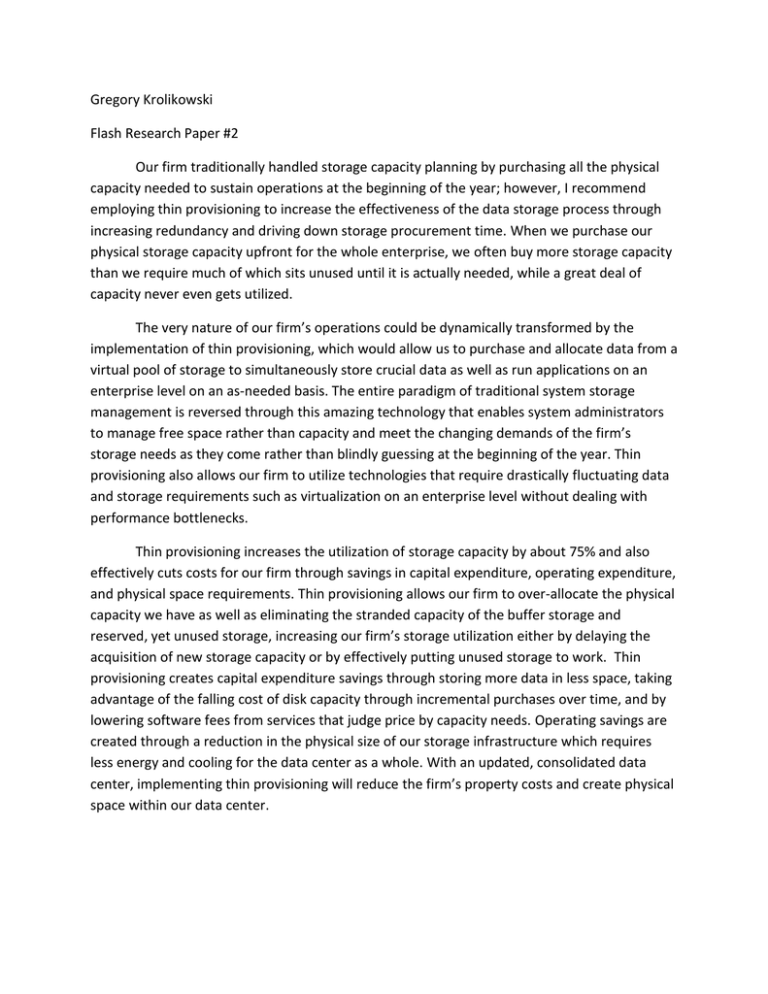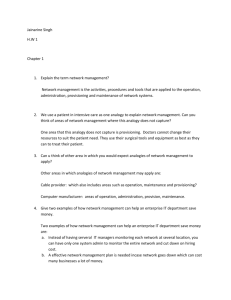Gregory Krolikowski Flash Research Paper #2
advertisement

Gregory Krolikowski Flash Research Paper #2 Our firm traditionally handled storage capacity planning by purchasing all the physical capacity needed to sustain operations at the beginning of the year; however, I recommend employing thin provisioning to increase the effectiveness of the data storage process through increasing redundancy and driving down storage procurement time. When we purchase our physical storage capacity upfront for the whole enterprise, we often buy more storage capacity than we require much of which sits unused until it is actually needed, while a great deal of capacity never even gets utilized. The very nature of our firm’s operations could be dynamically transformed by the implementation of thin provisioning, which would allow us to purchase and allocate data from a virtual pool of storage to simultaneously store crucial data as well as run applications on an enterprise level on an as-needed basis. The entire paradigm of traditional system storage management is reversed through this amazing technology that enables system administrators to manage free space rather than capacity and meet the changing demands of the firm’s storage needs as they come rather than blindly guessing at the beginning of the year. Thin provisioning also allows our firm to utilize technologies that require drastically fluctuating data and storage requirements such as virtualization on an enterprise level without dealing with performance bottlenecks. Thin provisioning increases the utilization of storage capacity by about 75% and also effectively cuts costs for our firm through savings in capital expenditure, operating expenditure, and physical space requirements. Thin provisioning allows our firm to over-allocate the physical capacity we have as well as eliminating the stranded capacity of the buffer storage and reserved, yet unused storage, increasing our firm’s storage utilization either by delaying the acquisition of new storage capacity or by effectively putting unused storage to work. Thin provisioning creates capital expenditure savings through storing more data in less space, taking advantage of the falling cost of disk capacity through incremental purchases over time, and by lowering software fees from services that judge price by capacity needs. Operating savings are created through a reduction in the physical size of our storage infrastructure which requires less energy and cooling for the data center as a whole. With an updated, consolidated data center, implementing thin provisioning will reduce the firm’s property costs and create physical space within our data center. Sources Cited Adams, April, and Gene Ruth. "Innovation Insight: Thin Provisioning Drives Cost Reduction." Gartner(2012): Gartner. Web. 3 Oct 2013. <http://my.gartner.com/portal/server.pt?open=512&objID=260&mode=2&PageID=346 0702&resId=2200015&ref=QuickSearch&sthkw=thin provisioning>. Lowe, Scott. "What is Thin Provisioning?." The Enterprise Cloud. Tech Republic, 24 JAN 2008. Web. 3 Oct. 2013. <http://www.techrepublic.com/blog/datacenter/what-is-thinprovisioning/274>. "Thin Provisioning." Infortrend. Infortrend Technology Inc., Web. 3 Oct 2013. <http://www.infortrend.com/global/Solutions/Softwares/thin_provision>.




